How to Fertilize Your Lawn with Coffee Grounds
If you have ever used fertilizer on your lawn, this article is going to be of interest to you.
There is an almost limitless supply of spent coffee grounds, from cafes and offices all around the country, and they are great for established lawns.
Using coffee grounds for your lawn also means you'll save a few dollars by not buying all that commercial fertilizer, most of which is labour intensive at every step from manufacture to your door. In a previous article titled How a Cafe turns coffee grounds to fertilizer, I highlighted why using the grounds directly from a cafe is the most environmentally friendly way to go.
The reason why coffee grounds are suitable as a fertilizer is because they are high in nitrogen, which is the same nutrient that is lost in the greatest quantity when lawn is mowed. The best period to apply fertilizer to lawns is when you see it starting to grow, because that is when it will make the most of what you put down.
Coffee grounds can also be used to build up the soil on which lawn or other plants are growing, and they can be used in up to 25% of a new garden bed, provided they are mixed in well with the remaining 75% of soil.
Selecting the Correct Grind for the Lawn
When you start collecting coffee grounds, you will notice that they come in different grind types. More often than not the coffee grounds coming from a cafe will have a fine grind, and the automated espresso machines tend to be a medium grind.
While the automated machine will give you the same grind every time, with cafes there is no fixed rule to this. I've seen some cafes that use a medium grind, and some grounds as fine as talcum powder. What seems to work best for the lawn is towards the medium side, because it is easier to spread and takes longer to break down once in the soil.
Steps to Fertilize the Lawn
1. Pour the coffee grounds onto an area of lawn you want to fertilize. Avoid doing this right after rain as the ground will be soggy and raking them in evenly is going to be difficult. Some folks prefer to take grounds by the handful and scatter them directly and that way is just fine, although this will take you longer, and will not be as evenly spread as the method below.
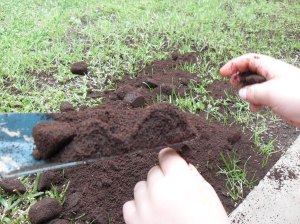
2. Break up the coffee grounds with a shovel or trowel, enough so that the large chunks are gone. It will cause you problems if those little coffee lumps are sitting on your lawn like mud pats, and it will take longer for them to breakdown than you want them to.
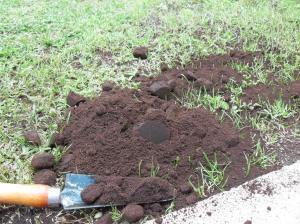
3. A wide head plastic rake will do the trick for spreading grounds, and a light metal one is also OK. Try to avoid a heavy rake as this will damage your lawn and not necessarily be any good at spreading the grounds around.
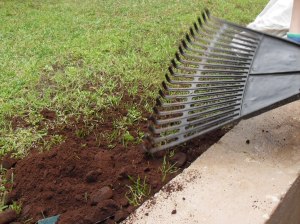
4. Start spreading the coffee grounds around the lawn in nice long even strokes.
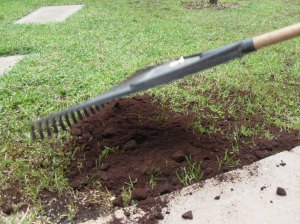
5. The grounds will disappear into the soil before too long. It is best to blend them over an area so that the lawn is only one quarter covered with grounds. Any more than that and it might cause problems with air and water movement through to the grass roots.
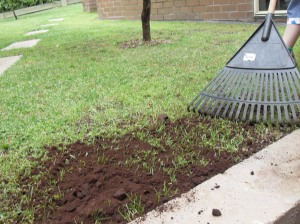
6. Now blended in nicely.
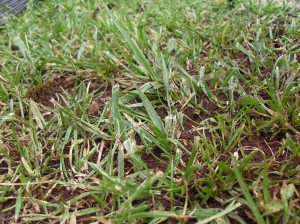
7. The final step is to water in the grounds, a good soak through will stop them from coming loose, giving them every chance to return to the soil.
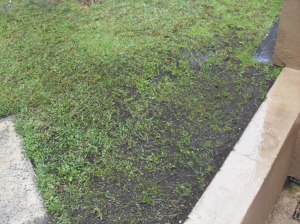
Spent coffee grounds for fertilizing your lawn is an effective and low cost solution which also makes a contribution to the environment. Using the grounds saves them from going to landfill, and you will have less of a need for those commercially manufactured products.
Just reapply every 8-10 weeks during the lawn growth period, and you will be rewarded in many ways.
To learn more about using coffee grounds in the garden, stop by the Ground to Ground site, fast become this subject's most comprehensive body of knowledge.